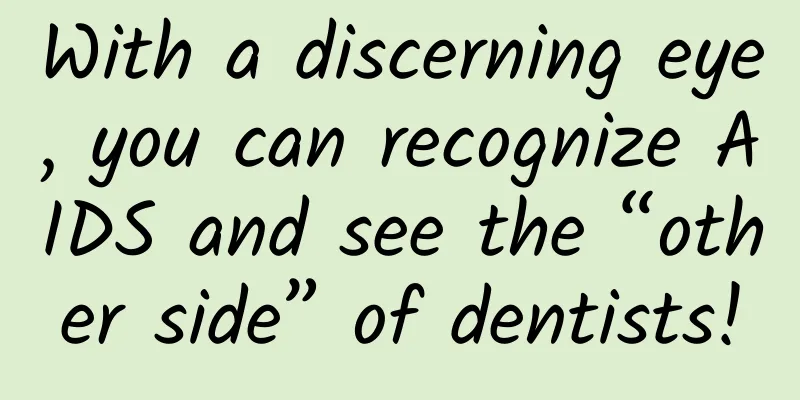With a discerning eye, you can recognize AIDS and see the “other side” of dentists!

|
As we all know, AIDS is an infectious disease with a high mortality rate. It is the natural outcome of infection with the human immunodeficiency virus (HIV). HIV has the ability to destroy the body's immune system and can cause many types of secondary infections. Because there are currently no effective treatments and treatments, infected people will eventually "die from the virus." AIDS can affect many systems and organs, and the oral cavity is likely to be one of the hardest hit areas. Some patients are even discovered because of oral diseases. So, what oral diseases can help us identify suspected AIDS patients? What are the special features of these oral diseases? 01 Oral diseases that are different from others 2 types of "spots" There are two types of "spots" that are closely related to AIDS, namely hairy leukoplakia and linear gingival erythema. Hairy leukoplakia It mainly occurs on the bilateral tongue edges, and may also affect the back and ventral sides of the tongue. Although it is called a spot, it is not flat and has wrinkles on the surface. The wrinkles run perpendicular to the lateral edges of the tongue and appear hairy when overproliferated. Hairy leukoplakia is highly associated with AIDS and is common in male patients. This type of spot is essentially a viral infectious disease, and herpes viruses can often be detected in the lesions. Unlike oral leukoplakia, abnormal epithelial hyperplasia is rarely seen in the lesions of hairy leukoplakia. Linear gingival erythema The characteristic manifestation is a well-defined fiery red change along the edge of the gums, which looks like a "gum line" but is actually gingival congestion. Unlike gingival congestion caused by general gingivitis, its cause is not dental plaque. Patients usually have good oral hygiene and little or no dental plaque. 2 types of tumors The two "tumors" that are closely related to AIDS are Kaposi's sarcoma and non-Hodgkin's lymphoma. Kaposi's sarcoma It is a rare vascular malignancy and the most common oral tumor in AIDS patients, most commonly in male patients. It often occurs in the palate and gums and appears as single or multiple brown, red, blue or purple plaques or nodules. Non-Hodgkin's lymphoma The primary symptom is painless cervical and supraclavicular lymphadenopathy, which is usually found in the soft palate, gums and tongue root, and is manifested as a fixed and elastic red or purple mass. This tumor is one of the indications for the diagnosis of AIDS. 02 “Unusual” common oral diseases Some oral diseases are not unique to AIDS patients, but they are more severe in AIDS patients than in non-AIDS patients. Oral candidiasis This disease is a fungal infection that can appear as an early oral manifestation in AIDS patients. Although non-AIDS patients may also suffer from this disease, it has unusual characteristics in AIDS patients: ① No inducement, that is, the patient has no history of radiotherapy, chemotherapy, long-term use of hormones or antibiotics, or other history of immunosuppression; ② More serious, severe or prone to recurrence. There are two types: erythematous or pseudomembranous. ③ Site of onset, namely, pseudomembranous oral candidiasis occurring in the attached gingiva (i.e., the gums attached to the bones) and the back of the mouth (pharynx, soft palate, and uvula), and erythematous oral candidiasis occurring in the cheeks. If any of the above three characteristics is present, it should be taken seriously. Oral herpes simplex Oral herpes simplex is a common oral mucosal disease that is recurrent and self-limiting. The healing time for non-AIDS patients is 1 to 2 weeks; the course of disease in AIDS patients is usually more than one month. AIDS-related periodontitis Unlike the usual chronic periodontitis caused by dental plaque, this type of periodontitis does not cause deep periodontal pockets, but the destruction of periodontal soft and hard tissues is more rapid, making the teeth more likely to loosen and fall out. Recurrent aphthous ulcers Recurrent oral ulcers in non-AIDS patients are mainly mild, while recurrent oral ulcers in AIDS patients are mainly severe and herpes type. Whether it is a "different" oral disease or an "unusual" common oral disease, they are closely related to HIV infection. These "AIDS" conditions are important indicators for diagnosing AIDS. It is not just a legend that dentists, especially oral mucosal disease doctors, can recognize AIDS with their keen eyes. But then again, by the time the dentist finds out, it is too late. When facing AIDS, prevention is always the first priority! |
>>: Can't drink boiled water or overnight water? I finally understand after reading this...
Recommend
How is the quality of Anjing Hotpot Meatballs? Where are Anjing Hotpot Meatballs produced?
The calorie content of hot pot meatballs is very ...
Female anal relaxation
If female friends find that there is looseness ar...
How do you open an oyster? Can you eat the black shit-like inside of an oyster?
Oysters in Europe and America mainly include edib...
What does it mean when the white blood cell count is high in pregnant women?
White blood cell count is one of the more importa...
If the fetus stops once, is it likely to stop next time?
Many pregnant women are very worried about fetal ...
What causes a woman's face to swell?
For most women, the face is actually a very impor...
Can mild thalassemia in the mother be inherited?
When a woman is around 12 years old, her sexual a...
Gray hair grows prematurely?! Lack of 3 nutrients will cause hair to age faster!
Personal image What are you most afraid of losing...
World Stroke Prevention Day丨Practical! Common knowledge of stroke first aid can save lives at critical moments!
Research has found that 9.77% of all strokes occu...
What is the hcg value when not pregnant
HCG is a hormone in the human body. You can use t...
Principles of frozen embryo transfer technology
There are many technologies for treating diseases...
Can a ketogenic diet treat epilepsy?
Epilepsy is a common neurological disease. During...
How to treat vaginal leukoplakia? These are the methods!
White spots can appear in many parts of the human...
Does body temperature rise after ovulation?
When we feel our body temperature rising, it is u...
What is the best medicine for women with frequent urination?
If women have symptoms of frequent urination and ...









